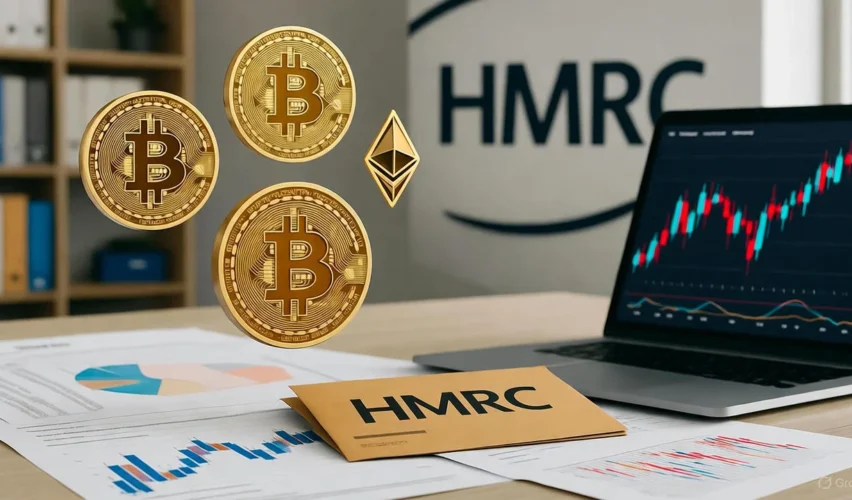What UK investors need to know about HMRC's sharp rise in crypto tax "nudge" letters for 2025
By UK Money Daily · Updated
If you've experimented with Bitcoin, ETH, or the newest altcoin, you might have come across rumors about HMRC's Sharp Rise in Crypto Tax "Nudge" Letters: What UK Investors Must Know for 2025. This guide explains what those letters mean, why they're coming now, and how to respond in a smart way that doesn't ruin your weekend.
A friend called me in a panic last month and said, "I've gotten a brown envelope from HMRC." Could I have inadvertently violated any regulations by exchanging ETH for SOL in 2022? He isn't the only one. Thousands of people in the UK are getting "nudge" letters that politely but firmly ask them to double-check their crypto tax. It's not a raid; it's a call to action. And yes, you can do it.
What do UK investors need to know about HMRC's sharp rise in crypto tax "nudge" letters for 2025?
A nudge letter is similar to HMRC gently reminding you, "We believe you may have unreported cryptocurrency activity—please review your tax return." While it's not an investigation, it serves as a serious warning to ensure your financial affairs are in order. HMRC has increased this outreach, sending out about 65,000 warning letters in the tax year ending April 2025. This is more than double what they sent out the year before. ftadviser.com
Using data from exchanges in the UK and other countries, nudge campaigns focus on common risk areas like crypto disposals, exchange-to-exchange swaps, staking rewards, and airdrops. When the Cryptoasset Reporting Framework (CARF) goes into effect, UK reporting cryptoasset service providers will have to collect and report user data every year. The new regulations will make things even more clear. GOV.UK
If you're not sure if this is "just a crypto thing," HMRC has been sending out nudge letters for a long time to people who are at risk of not paying their taxes. But crypto is now near the top of the list. bdo.co.uk
What is important for UK investors to know for 2025 is HMRC's sharp rise in crypto tax "nudge" letters.
In summary, both the rules and the numbers have undergone significant changes.
Volume: The rise to about 65,000 letters shows that this is a long-term campaign, not just a one-time mailshot.
Data firehose: Under CARF, starting in 2025, exchanges will have to send HMRC detailed customer data every year. This will make it easier for HMRC to keep track of your trades. GOV.UK
Lower allowances and rate changes: More people have to pay Capital Gains Tax (CGT) because the annual CGT exemption is now stricter. Furthermore, mid-cycle rate changes have made things more complicated, which means you're more likely to make mistakes if you use old software settings or guess. The Times
Policy pressure: Trade groups and professional organizations have been talking about HMRC's crypto letters since 2024, and the campaign has only gotten bigger. tax.org.uk
In short, HMRC is combining better data with outreach. Wishing it would "go away" is like wishing a blockchain rewrite would fix your basic calculations.
How to Use HMRC's Sharp Rise in Crypto Tax "Nudge" Letters: What UK Investors Need to Know for 2025—A Step-by-Step Guide
Step 1: Read the letter in a calm way.
It usually asks you to look over your return and correct any mistakes. It's a chance to resolve problems before a formal investigation. bdo.co.uk
Step 2: Make a list of your taxable events.
Cryptocurrency tax isn't just "cash out to GBP." In the UK, disposals include selling, trading one token for another, giving it away (to someone apart from a spouse or civil partner), and spending crypto. You may have to pay taxes on staking rewards and some airdrops. The Cryptoassets Manual from HMRC is the most reliable and up-to-date source. GOV.UK
Step 3: Put together the records again.
Get CSVs and statements from all the wallets and exchanges you've used, both centralized and decentralized. Make one ledger that shows the dates, token amounts, GBP value at the time, fees, and running cost basis. Don't worry if your past self wasn't careful; tools and advisors can help.
Step 4: Figure out your income and gains again.
Follow UK rules for pooling shares and what costs are allowed. Please ensure that any staking yields or mining income are handled correctly before they are applied to CGT upon sale. If you're not sure, look at the examples in the HMRC manual. GOV.UK
Step 5: Correct it by using the self-assessment or disclosure route.
If you see amounts that were not reported correctly, you can either change your self-assessment (within the time limits) or use the disclosure option mentioned in the letter. Responding is better than staying quiet; if you don't respond to a nudge, you could end up with questions and fines. Recent advice says that waiting could lead to big fines.
Step 6: Make sure your process will work in the future.
Use a tracking tool that aligns with UK tax regulations, maintain accurate records, and label wallets to distinguish between transfers and disposals. When CARF is coming up, clean data is your best friend. GOV.UK
Examples and short case studies
The person who swaps without talking: A DEX fan from 2021 to 2023 never cashed out to GBP, thinking, "No tax until I withdraw." They got a push. After putting together swaps again, they found many chargeable disposals and a little bit of income from airdrops. They changed their returns, paid CGT, and didn't have to answer any questions.
The part-time staker: A PAYE worker puts tokens on an exchange. They correctly reported CGT on sales, but they didn't report staking income. Once they re-downloaded the statements and correctly divided the GBP values, the correction was easy.
Confusion about cold wallets: An investor moved tokens from one wallet to another. That's not a disposal. Good labels and a transfer reconciliation kept people from accidentally reporting too much.
What you can gain by taking HMRC's nudge seriously
By fixing things early, you can lower your risk of penalties and interest. bdo.co.uk
Cleaner audit trail for the CARF era, when data from exchanges will check your return. GOV.UK
You can make better portfolio decisions when you can see your taxable reality, not just your P&L on screen.
Key considerations and limitations to keep in mind
Software is not a magic bullet: There are many tools that can help, but DeFi still needs people to check for mismatched timestamps, missing fees, and bridging/LP events.
Changes to rates and allowances: Don't assume that the settings from last year will still work in 2024–25. Because of changes in the middle of the cycle, HMRC systems may need to be checked manually until they catch up. The Times
Records can be difficult to locate when trading with other countries. Begin early to ask for archives or API pulls.
Not every letter looks the same: HMRC sends out different types of nudges, and some need proof of completion. Please review the instructions included with your letter. bdo.co.uk
What UK investors need to know about HMRC's sharp rise in crypto tax "nudge" letters in 2025, plus tips on how to protect yourself
Am I required to pay taxes if I have not sold to GBP?
Maybe. Exchanging one token for another is considered a disposal and may result in Capital Gains Tax (CGT). CGT.GOV.UK
What if I didn't get a letter?
You may still have to report. Experts say that not getting a letter doesn't mean everything is fine; HMRC is getting more access to data. TradingView
What records do I need to keep?
Dates, amounts, GBP values, fees, wallet or exchange identifiers, purpose (swap, sale, transfer), and proof of income events. HMRC wants strong records. GOV.UK
What do the new rules mean for 2026?
Exchanges will have to send user data to HMRC once a year because of CARF. This will make it easier to match data and lower the number of "unknowns." Start building beneficial habits now. GOV.UK
Could problems with software rating affect my return?
Yes, recent news stories talked about problems with CGT rate changes and manual adjustments. Check your math again or ask for help. The Times
Quick list of protection tips:
Use tax tools that are aware of the UK; check every wallet and exchange.
Don't wait until the end of the year to export CSVs. Do it every month.
Tag internal transfers to avoid throwing things away by mistake.
Keep fiat statements to prove the value of GBP.
If you receive a nudge, answer by the deadline, even if it's just to ask for more time to gather records. bdo.co.uk
In conclusion
If you receive a nudge letter, think of it like a smoke alarm: it's annoying but meant to keep you safe. HMRC's campaign is bigger, louder, and has more and more exchange data to back it up. If you take care of the basics—keeping records, putting things in the right category, and making changes on time—you'll probably turn a stressful envelope into a normal office job. Want to feel safe in 2026 and beyond? Now is the time to start cleaning.
Links to outside sources (trusted sources)
The official rules and examples for cryptoassets from HMRC are on GOV.UK.
GOV.UK: Implementing the Cryptoasset Reporting Framework (CARF)
FT Adviser says that there has been a rise in HMRC crypto warning letters.
The Times gives some background on the rate and allowance issues for 2024–25. The Times
Early warnings from professional organizations—an overview from tax.org.uk













